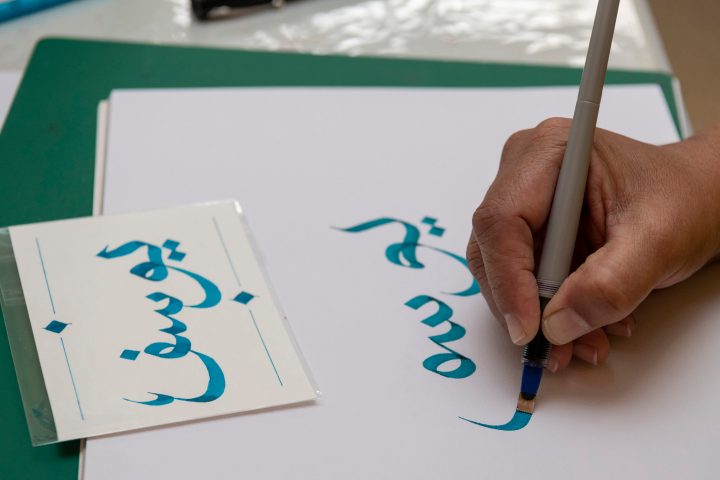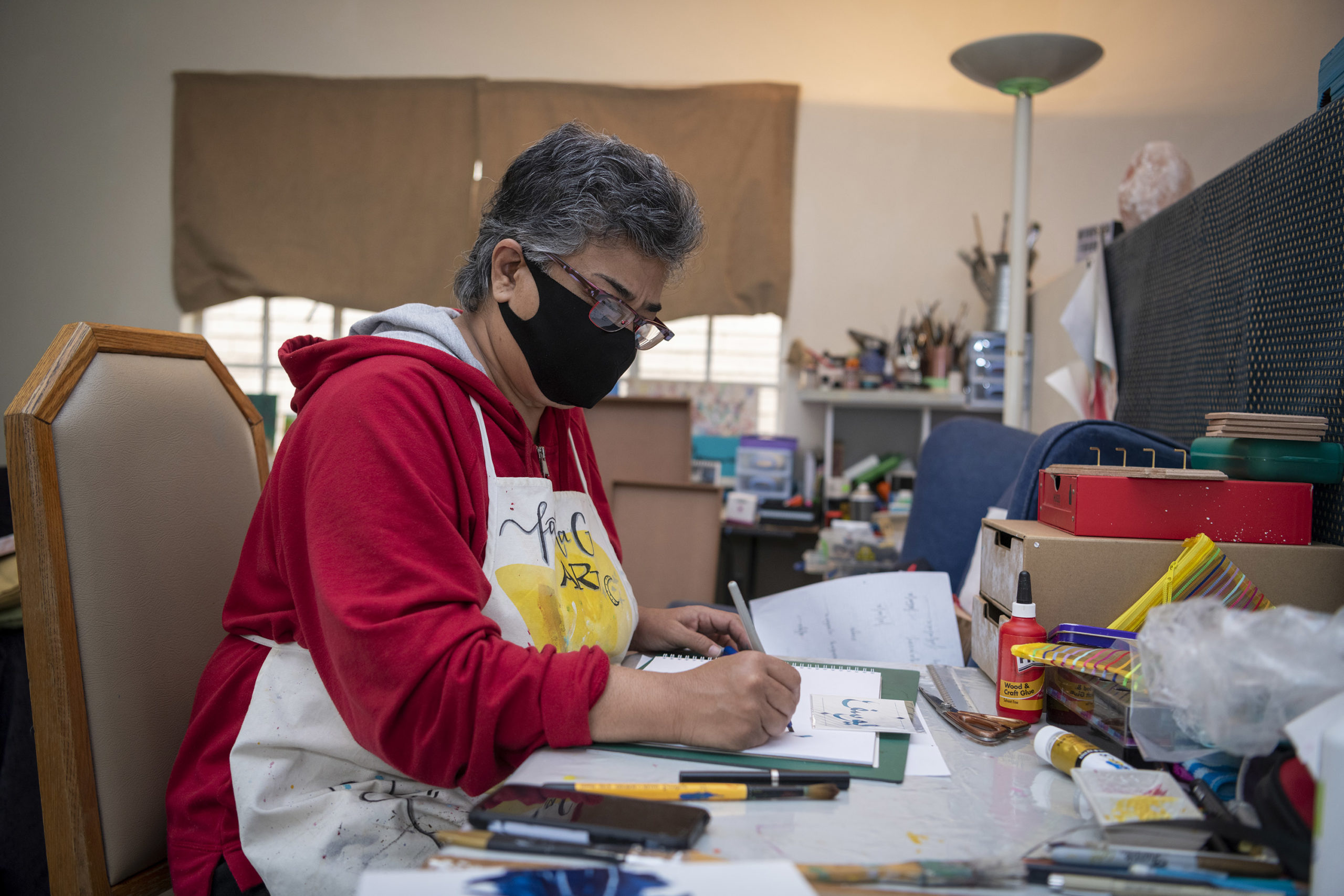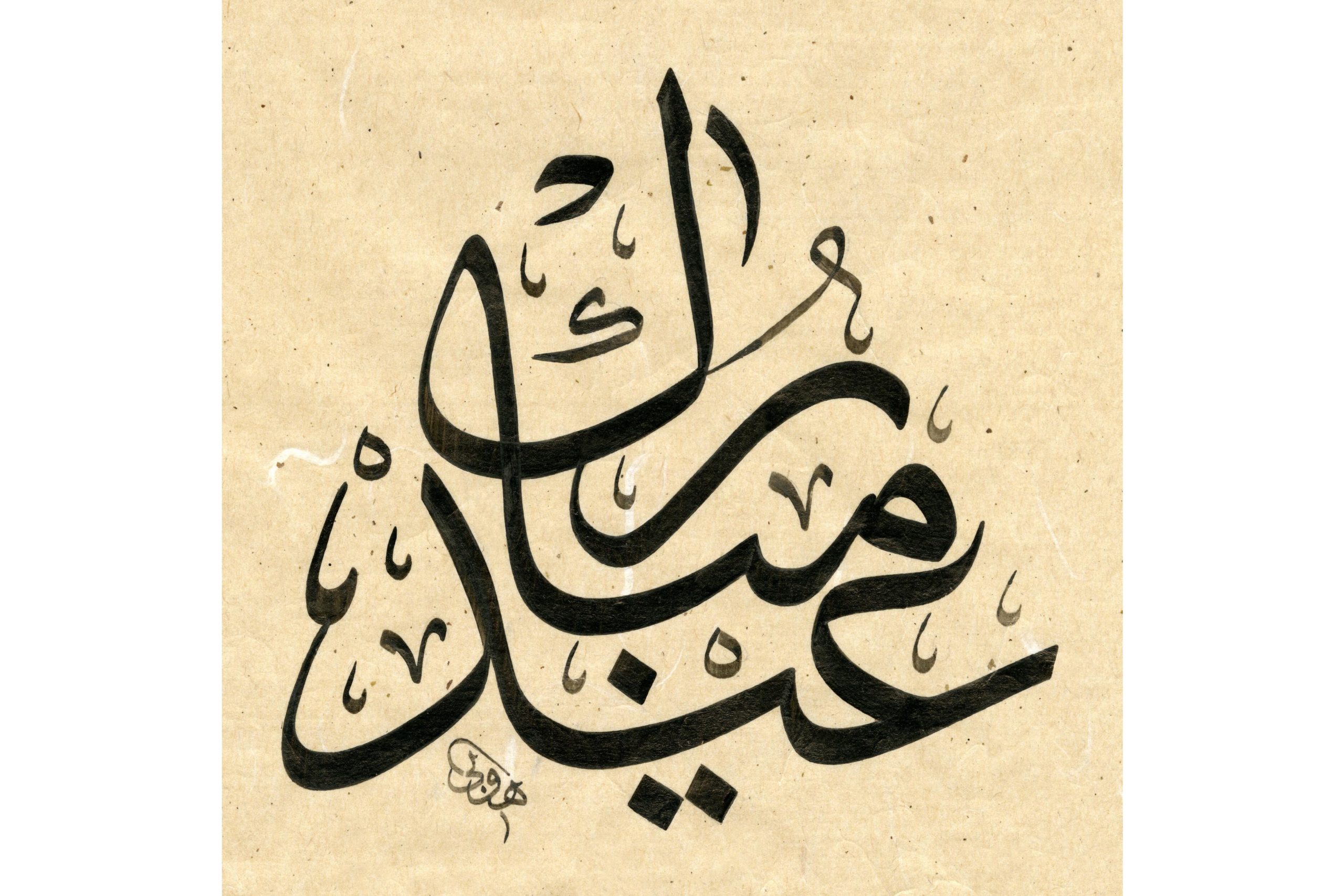NEW FRAME
Arabic calligraphy and the art of social justice

Three exponents of Arabic script reflect on the meaning, spirituality and activism of their craft and how they use it to celebrate faith and practise everyday compassion.
This story was first published on New Frame.
After years of working and volunteering as an international solidarity activist in occupied Palestine, and as an environmentalist and education-rights activist in South Africa, artist Fatima Gabru from Azaadville in Gauteng is one of a growing number of Muslims who have turned to the calligraphy pen to express the connection between social justice and Islam.
She crafts the calligraphy pens, known as qalams, herself from bamboo that she harvests at a friend’s house. Before the Covid-19 enforced lockdown, Gabru exhibited her work at forums like the Lenasia Art Exhibition in 2019. She has since turned to selling her work and qalams on Instagram and teaching introductory Arabic calligraphy to small groups.
“I work in acrylics mostly, and sometimes watercolours or gouache for the backgrounds. For the lettering, I use acrylic paint as well as different inks. I use lots of Arabic words and phrases that have universal appeal and are key concepts in Islam, such as salaam (peace), hub (love), As-Salaamu-Alaikum (Peace be unto you). It is an enjoyable practice and it is meditative because when I practise it, I am repeating the phrase all the time. Now that it is Ramadan, calligraphy is even more tied to my spirituality and it is an expression of beauty about faith,” says Gabru.

7 May 2021: Artist Fatima Gabru practicing Arabic calligraphy at her studio in Azaadville, west of Johannesburg. Picture: Ihsaan Haffejee
As an activist, Gabru contemplated whether there was a direct link between activism and her new passion for Arabic calligraphy. “I would say my current work is not deeply connected to social justice yet, because I am only a beginner in what is a life-long practice. But when I practise longer phrases from the Quran, I often choose phrases of social justice that speak to the equality of human beings,” she says.
Gabru hopes one day to reach the level required to study under a master calligrapher, which would require much more intense practising. She is inspired by Muhammad Hobe, who is from Zigudu village near Cofimvaba in the Eastern Cape.
Arabic script in a Xhosa hand
Hobe was born in a hut at Zigudu village near Cofimvaba in 1981, during apartheid. He became a Muslim at the age of 10 after his father reverted to Islam. Because he was praised for his beautiful handwriting, he took up the art of Arabic calligraphy and moved to Turkey in 2009 where he now practices as a master calligrapher and was granted Turkish citizenship for his services to Islamic arts.

Eid Mubarak | Cambridge Muslim College. By Muhammad Hobe.
Currently in his 10th year of study under eminent Turkish Arabic calligrapher Hasan Çelebi, Hobe achieved his diploma in Arabic calligraphy and has plans to return to South Africa and bring the art to townships. He usually conducts yearly workshops in South Africa but has not been able to return since the Covid-19 pandemic broke out.
“After gaining the skills from my teacher, my hope is to train the youth in South Africa in various traditional art forms such as paper marbling, Arabic calligraphy and Islamic geometry so that they become fully equipped to be recognised internationally,” he says.
“I would hope to run workshops in the townships because that is where most of the youth are jobless. The calligraphy and arts will help the youth, so the townships are a must,” Hobe says.
It is possible to make a living from Arabic calligraphy, Hobe says. “I teach calligraphy and am a full time calligrapher. I am often commissioned – currently I am working on a commission from the prime minister of Malaysia.”
Reflecting on his work during Ramadan, Hobe said Arabic calligraphy “requires one to be disciplined and forces one to attain qualities like patience, humility and perseverance. There are many examples of the link between spirituality and Arabic calligraphy, but this is what I think of now – that you gain these qualities over time.”
An American in the Arab world
American artist Everitte Barbee learnt Arabic and moved to Lebanon. He uses Arabic calligraphy to highlight oppression and injustice. Although he is not Muslim, Barbee often illustrates chapters from the Quran, called surahs, to combat Islamophobia. For Ramadan, Barbee had used Arabic calligraphy to illustrate Surah 83 – the entire chapter – as part of his ongoing project to rewrite the whole Quran by hand, in picture form.
“At this time of fasting and contemplation I hope we can remember to be more generous. Even as the chaos of Covid and economic collapse here make it harder to see security in our future, only our compassion, generosity and caring for those around us will protect us going forward into such unknown times,” Barbee said when he released Surah 83 on 1 May.

Palestine Rocks. by Everitte Barbee
Barbee is also known for using Arabic calligraphy to craft the writings of historic and contemporary Middle Eastern poets such as the 13th century Iraqi poet Bahai Al-Din Zuhair and Palestine’s national poet, the late Mahmoud Darwish, into images of hearts, women, animals and geometric shapes.
Perhaps drawing inspiration from one of Palestine’s most prominent writers, Ghassan Kanafani, Barbee’s work includes a map of 1948 Palestine, before it was colonised by Israel, entirely illustrated by the names of the Palestinian towns and villages that were ravaged by the newly established state of Israel during the Nakba (the Palestinian catastrophe of 1948, in which many villages were destroyed, history erased and people displaced).
Haidar Eid, associate professor of English literature at the Al-Aqsa University in the Gaza Strip, says Kanafani, who was also the spokesperson for the socialist Popular Front for the Liberation of Palestine, popularised Arabic calligraphy in the struggle with his iconic 1970 calligraphy work of the word “Falasteen” (Palestine). “He was also an artist and he wrote the word Falasteen in fantastic calligraphy that was also used by so many Palestinian revolutionary magazines and also as a poster by the Palestinian revolution ever since,” says Eid.
Like Kanafani, Barbee has used Arabic calligraphy to mould these important words of liberation into an iconic image – this time of unarmed Palestinians throwing stones at heavily armed Israeli soldiers:
We do not throw these rocks with hate.
We throw these rocks with love,
Love for a murdered brother,
Love for a sick grandmother without medicine,
Love for a family we cannot visit,
Love for a world we will never travel,
Love for a freedom we will never experience,
Love for an ancient people.
We throw these rocks with love for Palestine. DM/ML
















 Become an Insider
Become an Insider
Comments - Please login in order to comment.